Hollis Montessori have shared a ‘Montessori Dictionary’, helping families understand some of the common terms used in a Montessori environment.
Absorbent Mind – A mind able to absorb knowledge quickly and effortlessly. Montessori said the child from birth to six years has an “absorbent mind.”
Adaptation – Related to the idea of an absorbent mind (Haines, 1993) is a special power of the young child that can be called the power of adaptation. This power is a process whereby the young child absorbs the culture of her time and place, taking in all the spirit, the customs, the ambitions and attitudes of a society simply by living in that society.
Analysis of movement – A technique used by Montessori teachers. The adult, when showing a complex action to a child, breaks it down into its parts and shows one step at a time, executing each movement slowly and exactly. The action thus becomes a sequence of simple movements and the child has a greater chance of success when “given the liberty to make use of them” (Montessori, 1966, p. 108).
Children’s House – The English name for Montessori’s Casa dei Bambini (Italian). A place for children from 3-6 years to live and grow. Everything necessary for optimal human development is included in a safe and secure environment.
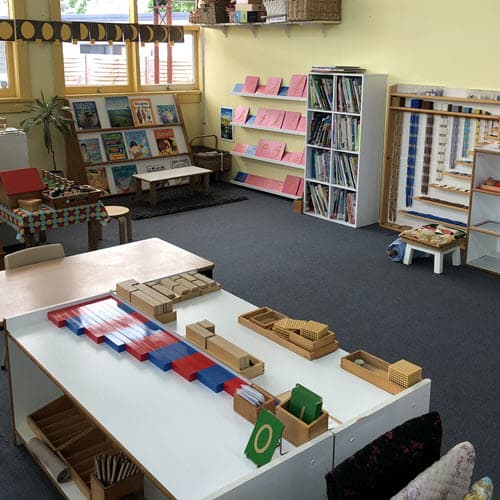
Classification – Sorting. Allocating or distributing according to common characteristics. The young child engages in classification activities because the process is essential for the construction of the intellect. The Montessori classroom offers many opportunities for classification.
Concentration – The act of concentrating. The young child focuses his attention on aspects of the environment essential for development. From a Montessori perspective, concentration is “a consistent activity concentrated on a single work—an exercise on some external object, where the movements of the hands are guided by the mind” (1983, p. 149). Deep engagement.
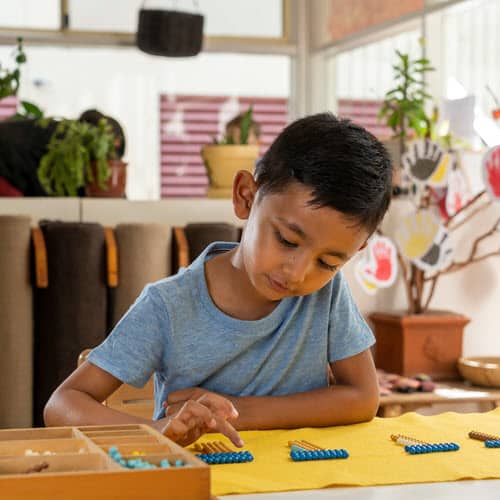
Concrete to Abstract – A progression both logical and developmentally appropriate. The child is introduced first to a concrete material that embodies an abstract idea such as size or color. Given hands-on experience, the child’s mind grasps the idea inherent in the material and forms an abstraction. Only as the child develops, is she gradually able to comprehend the same idea in symbolic form.
Control of Error – A way of providing instant feedback. Every Montessori activity provides the child with some way of assessing his own progress. This puts the control in the hands of the learner and protects the young child’s self-esteem and self-motivation. Control of error is an essential aspect of auto-education.
Coordination of Movement – One of the major accomplishments of early childhood. Through the child’s own activity, she refines her muscular coordination and consequently acquires increasingly higher levels of independent functioning. Because of this developmental need, children are drawn to activities that involve movement and especially to pastimes, which demand a certain level of exactitude and precision.
Creativity/Imagination – Imagination involves the forming of a mental construct of what is not actually present to the senses. Creativity is a product of the imagination and results from the mental recombining of imagined ideas in new and inventive ways. Both are dependent on mental imagery formed through sensorial experience.
Cycle of Activity – Little children, when engaged in an activity which interests them, will repeat it many times and for no apparent reason, stopping suddenly only when the inner need which compelled the child to activity has been satisfied. To allow for the possibility of long and concentrated work cycles, Montessori advocates a 3-hour uninterrupted work period.
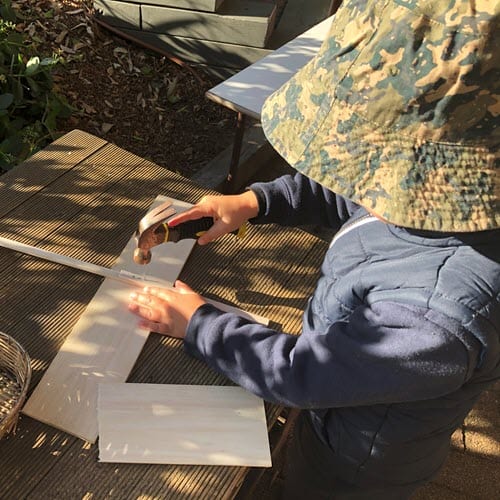
Development of the Will – The ability to will, or choose, to do something with conscious intent develops gradually during the first phase of life and is strengthened through practice. The Montessori environment offers many opportunities for the child to choose. Willpower, or self-control, results from the many little choices of daily life in a Montessori school.
Deviations – Behavior commonly seen in children that is the result of some obstacle to normal development. Such behavior may be commonly understood as negative (a timid child, a destructive child, etc.) or positive (a passive, quiet child). Both positive and negative deviations disappear once the child begins to concentrate on a piece of work freely chosen.
Discipline from Within – Self-discipline. The discipline in a well-run Montessori classroom is not a result of the teacher’s control or of rewards or punishments. Its source comes from within each individual child, who can control his own actions and make positive choices regarding personal behavior. Self-discipline is directly related to development of the will.
Exercises of Practical Life – One of the four areas of the Montessori prepared environment. The exercises of Practical Life resemble the simple work of life in the home: sweeping, dusting, washing dishes, etc. These purposeful activities help the child adapt to his new community, learn self-control and begin to see himself as a contributing part of the social unit.
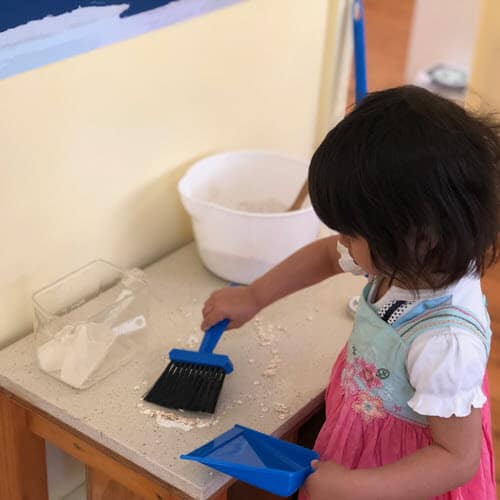
False Fatigue – A phenomenon observed in Children’s Houses around the world—often at approximately 10 am. The children seem to lose interest in work, their behavior becomes disorderly and the noise level rises. It may appear as if the children are tired. However, if the directress understands this is simply false fatigue, they will return to work on their own and their work will be at an even higher level than before.
Grace and Courtesy – An aspect of Practical Life. Little lessons which demonstrate positive social behavior help the young child adapt to life in a group and arm her with knowledge of socially acceptable behavior: practical information, useful both in and out of school.
Help from Periphery – The periphery is that part of the child that comes into contact with external reality. The child takes in impressions through the senses and through movement. Help from the periphery means presenting objects and activities in such a way so as to evoke purposeful movement on the part of the child. “We never give to the eye more than we give to the hand.” (Standing, 1957, p. 237)
Human Tendencies – A central tenet of Montessori philosophy is that human beings exhibit a predisposition towards exploration, orientation, order, abstraction, work, self-perfection, communication and a spiritual life. These tendencies are universal, spanning age, cultural and racial barriers; they have existed since the dawn of the species and are probably evolutionary in origin. “Montessori stresses the need to serve those special traits that have proved to be tendencies of Man throughout history.” (Mario Montessori, 1966, p.21)
Independence – Not depending on another—“with various shades of meaning” (OED, p. 836). Normal developmental milestones such as weaning, walking, talking, etc. can be seen as a series of events which enable the child to achieve increased individuation, autonomy and self-regulation. Throughout the four planes of development, the child and young adult continuously seek to become more independent. It’s as if the child says, Help me to help myself.
Isolation of a difficulty – Before giving a presentation, the Montessori teacher analyzes the activity she wants to show the child. Procedures of movements that might prove troublesome are isolated and taught to the child separately. For example, holding and snipping with scissors, a simple movement, is shown before cutting curved or zigzag lines; folding cloths are shown before table washing an activity requiring folding. A task should be neither so hard that it is overwhelming, nor so easy that it is boring.
Indirect Preparation – The way nature has of preparing the intelligence. In every action, there is a conscious interest. Through this interest, the mind is being prepared for something in the future. For example, a young child will enjoy the putting together various triangular shapes, totally unaware that because of this work his mind will later be more accepting of geometry. Also called remote preparation, the deeper educational purpose of many Montessori activities is remote in time.
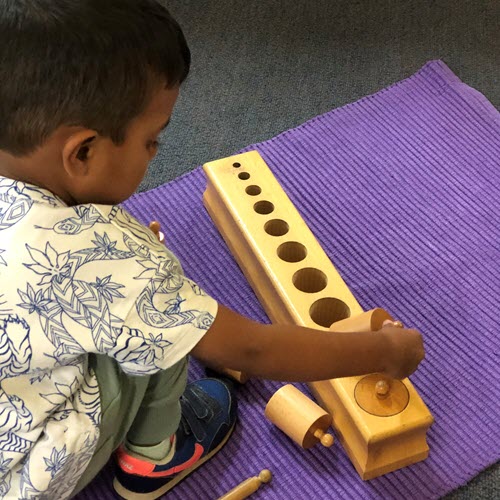
Language Appreciation – From the very first days in the Montessori classroom, children are given the opportunity to listen to true stories about known subjects, told with great expression. Songs, poems and rhymes are a part of the daily life of the class. The teacher models the art of conversation and respectfully listens to her young students. Looking at beautiful books with lovely, realistic pictures are also a part of language appreciation.
Learning Explosions – Human development is often not slow and steady; acquisitions seem to arrive suddenly, almost overnight, and with explosive impact. Such learning explosions are the sudden outward manifestation of a long process if internal growth. For example, the explosion of spoken language around two years of age is the result of many months of inner preparation and mental development.
Mathematical Mind – All babies are born with mathematical minds, that is, they have a propensity to learn things which enhance their ability to be exact and orderly, to observe, compare, and classify. Humans naturally tend to calculate, measure, reason, abstract, imagine and create. But this vital part of intelligence must be given help and direction for it to develop and function. If mathematics is not part of the young child’s experience, his subconscious mind will not be accepting of it at a later date.
Maximum Effort – Children seem to enjoy difficult work, which tests their abilities and provides a sense of their growing power. They exult in giving their maximum effort. For example, a tiny child will struggle to carry a tray with juice glasses or push a heavy wheelbarrow whereas school-age children, if allowed to make up their own problems will prefer to sink their teeth into a challenging equation (1+2+3+40+10)/2 rather than drill on 3+5=8 and 6+2=8.
Memory Games – During the 3-6 period, children are building their memory. Sensorial Games provide children an opportunity to strengthen their mental muscles. A typical game goes like this: A child picks up a geometric shape from a drawer, lightly traces the shape with her fingers and then sets it back on the table. She then must carry that shape in her mind as she walks across a room full of distractions and finds its match amongst a set of cards at the opposite end of the room. Games like this build visual memory, a key component of reading. Similar games can be played in other sensory modes: auditory, tactile, etc.
Mixed Ages – One of the hallmarks of the Montessori method is that children of mixed ages work together in the same class. Age-groupings are based on developmental planes. Children from 3-6 years of age are together in the Children’s House; 6-9 year-olds share the lower elementary and the upper elementary is made up of 9-12 year-olds. Because the work is individual, children progress at their own pace; there is cooperation rather than competition between the ages.
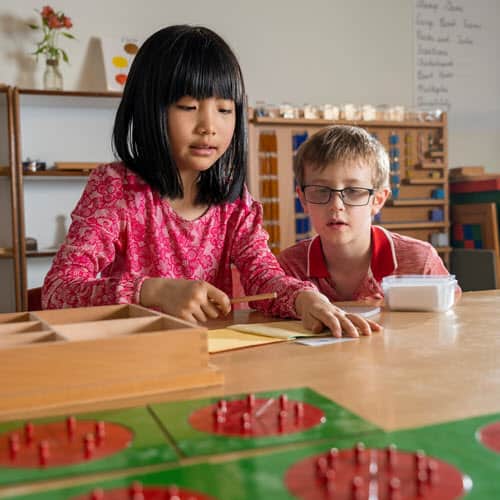
Normalization – If young children are repeatedly able to experience periods of spontaneous concentration on a piece of work freely chosen, they will begin to display the characteristics of normal development: a love of work, an attachment to reality, and a love of silence and working alone. Normalized children are happier children: enthusiastic, generous, and helpful to others. They make constructive work choices and their work reflects their level of development.
Obedience – Obedience is an act of will and develops gradually, showing itself “unexpectedly at the end of a long process of maturation.” (Montessori, 1967, p. 257). While this inner development is going on, little children may obey occasionally, but be completely unable to obey consistently. As their will develops through the exercise of free choice, children begin to have the self-discipline or self-control necessary for obedience.
Points of Interest – Montessori realized that if children spent too long a time on a complex task or failed to master the necessary details, the exercise would cease to interest them. Therefore she suggested that points of interest be interspersed throughout each activity. These points guide the child toward his goal and stimulate repetition and interest by offering immediate feedback, or what Montessori called “control of error.” The child’s performance becomes refined through trial and error, the points of interest acting as sign posts along the path to success.
Prepared Environment – the Montessori classroom is an environment prepared by the adult for children. It contains all the essentials for optimal development but nothing superfluous. Attributes of a prepared environment include order and reality, beauty and simplicity. Everything is child-sized to enhance the children’s independent functioning. A trained adult and a large enough group of children of mixed ages make a vital part of the prepared environment.
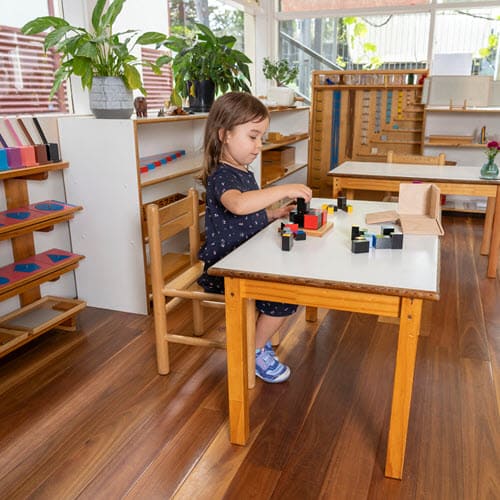
Presentation – The adult in a Montessori environment does not teach in the traditional sense. Rather she shows the child how to use the various objects and then leaves them free to explore and experiment. This act of showing is called a presentation. To be effective, it must be done slowly and exactly, step by step, and with a minimum of words.
Psychic Embryo – The first three years of life is a period of mental creation, just as the 9 months in utero is a period of physical creation. The brain awaits experience in the environment to flesh out the genetic blueprint. Since so much mental development occurs after birth, Montessori called the human infant a psychic embryo.
Repetition – The young child’s work is very different from the adult’s. When an adult works, he sets out to accomplish some goal and stops working when the object has been achieved. A child, however, does not work to accomplish an external goal but rather an internal one. Consequently, they will repeat an activity until the inner goal is accomplished. The unconscious urge to repeat helps the child to coordinate a movement or acquire some ability.
Sensitive Periods – Young children experience transient periods of sensibility, and are intrinsically motivated or urged to activity by specific sensitivities. A child in a sensitive period is believed to exhibit spontaneous concentration when engaged in an activity that matches a particular sensitivity. For example, children in a sensitive period for order will be drawn to activities that involve ordering. They will be observed choosing such activities and becoming deeply concentrated, sometimes repeating the activity over and over, without external reward or encouragement. Young children are naturally drawn towards those specific aspects of the environment which meet their developmental needs.
Sensorial Materials – The sensorial materials were created to help young children in the process of creating and organizing their intelligence. Each scientifically designed material isolates a quality found in the world such as color, size, shape, etc. and this isolation focuses the attention on this one aspect. The child, through repeated manipulation of these objects, comes to form clear ideas or abstractions. What could not be explained by words, the child learns by experience working with the sensorial materials.
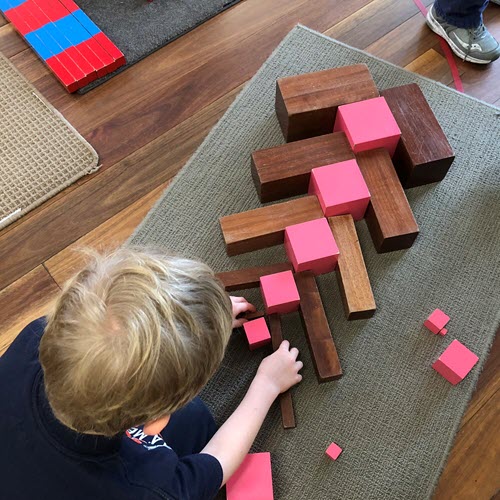
Simple to Complex – A principle used in the sequence of presentations in a Montessori classroom. Children are first introduced to a concept or idea in its simplest form. As they progress and become capable of making more complex connections, they are eventually able to handle information that is less isolated.
Socialization – “The process by which the individual acquires the knowledge and dispositions that enables him to participate as an effective member of a social group and a given social order” (Osterkorn, 1980, p. 12). “Optimal social learning takes place when the children are at different ages” (Hellbrugge, 1979, p. 14).
Sound Games – Many children know the alphabet but have not analyzed the sounds in words nor are they aware that words are made up of separate sounds (phonemic awareness). From the age of two (or as soon as the child is speaking fluently), sound games can make them aware of the sounds in words. In England, they use the nursery game “I Spy.” The sound of the letter and not the letter name is pronounced.
Three Hour Work Cycle – Through years of observation around the world, Montessori came to understand that children, when left in freedom, displayed a distinct work cycle which was so predictable it could even be graphed. This cycle, with two peaks and one valley, lasted approximately three hours. In Montessori schools children have three hours of open, uninterrupted time to choose independent work, become deeply engaged, and repeat to their own satisfaction.
Three Period Lesson – “The famous three period lesson of Sequin” (Standing, 1957, p. 307) is actually quite simple. The first period is NAMING: “This is thick. This is thin.” The second period is RECOGNITION: “ Give me the thick. Give me the thin.” The third period consists of THE PRONUNCIATION OF THE WORD: “ What is this?” In three simple steps, the entire learning process is brought into plan. The three period lesson is used for giving language.
Vocabulary Enrichment – The young child’s vocabulary increases exponentially in the years from 3-6. To feed this natural hunger for words, vocabulary is given: the names of biology, geometry, geography, and so forth, can be learned as well as the names of qualities found in the Sensorial Material. The child’s absorbent mind takes in all these new words “rapidly and brilliantly” (Montessori, 1946, p. 10).
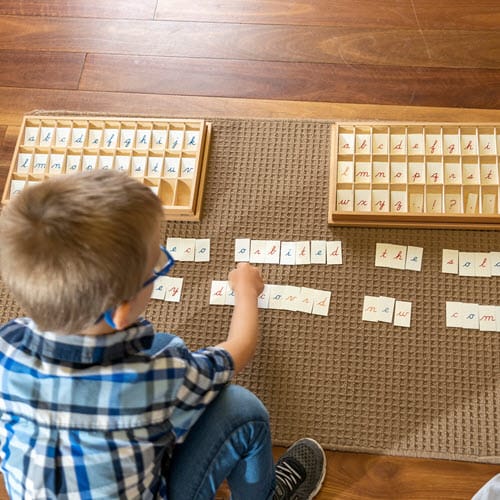
Work – From an evolutionary perspective, the long period of childhood exists so children can learn and experiment in a relatively pressure-free environment that most social scientists refer to as play (e.g., see Groos, 1901), although Montessori preferred to call this activity the “work” of childhood. Children certainly are serious when engaged in the kind of play that meets developmental needs and, given freedom and time, will choose purposeful activities over frivolous make believe ones.
Writing to Reading – In a Montessori environment, children usually begin writing before they can read. They are keen to create words with a box of loose letters (the moveable alphabet) or write their words with chalk or pencil. About six months later, they begin to understand what reading means, and they do so only through associating it with writing (Montessori, 1936/1983, p. 142). Source: Annette Haines, January 2001



